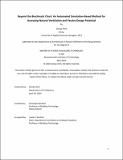Beyond the Bioclimatic Chart: An Automated Simulation-Based Method for Assessing Natural Ventilation and Passive Design Potential
Author(s)
Herb, Svenja
DownloadThesis PDF (5.436Mb)
Advisor
Reinhart, Christoph
Terms of use
Metadata
Show full item recordAbstract
Technological advancements in the building industry have significantly transformed climate and comfort control in buildings. This allows for air conditioning in deserts and heating in the Arctic, ensuring occupant comfort. This innovation, however, has contributed to a homogenization in architectural designs globally, from the hot climates of Mumbai to the cold environments of Boston, and moderate settings like London. Such uniformity often overlooks local climatic conditions, resulting in increased energy consumption and elevated greenhouse gas emissions. Climate-responsive design on the other hand creates solutions that leverage local climates—such as through natural ventilation and optimal solar gain management—to reduce energy consumption. Depending on climate and program, the coordinated use of these passive design strategies may or may not lead to indoor thermal comfort conditions without the need for an air-conditioning system. There are two primary approaches to explore the passive design potential of a building during schematic design: Bioclimatic chart and building energy modeling (BEM). The former method is a key feature in building science textbooks and is solely based on widely available local weather data. It provides general design advice without requiring previous knowledge or the need to describe the building program. BEMs facilitate detailed testing of how a building is operated and how the above listed passive design techniques can be combined to obtain the highest possible comfort conditions and energy savings. However, the use of BEM has traditionally been more complex and time-consuming to use as it requires significant knowledge of the underlying building physics and numeric methods to mimic them. This thesis evaluates the bioclimatic chart's accuracy in predicting overheating hours associated with various passive design strategies, through comparison with BEM data. Furthermore, it introduces a new simulation-based approach called “ECOmpass”. ECOmpass automates early-stage design simulations and offers design recommendations for passive strategies with just one click.
Date issued
2024-05Department
Massachusetts Institute of Technology. Department of ArchitecturePublisher
Massachusetts Institute of Technology